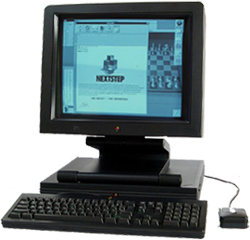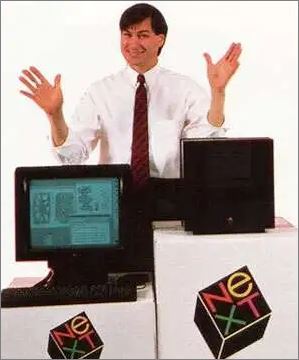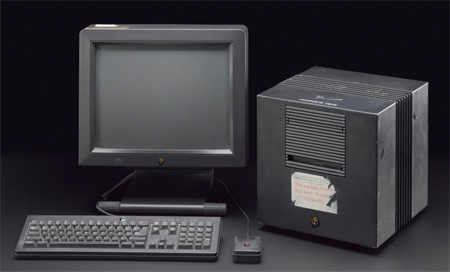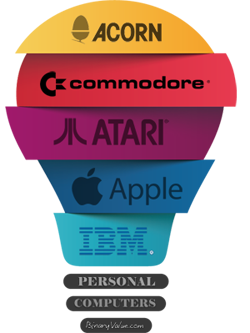"NeXT WorkStation.. The Savior of Macintosh"

Launched in 1988, the NeXT Computer was a groundbreaking workstation developed by NeXT Inc., the company founded by Steve Jobs after his departure from Apple. NeXT produced these machines until 1993, and in a twist of history, Apple acquired NeXT in 1996 for over $400 million, laying the foundation for macOS as we know it today.
-
The original NeXT Computer debuted in October 1988 with a price tag of $6,500 (equivalent to $15,900 today)
-
In 1990, the high-end NeXTcube followed, priced at $7,995 ($17,800 in 2023)
-
The NeXTstation, a more affordable desktop version, launched at $4,995 ($11,100 today)
-
Approximately 50,000 units were sold (excluding government and institutional sales)
![]() AT A GLANCE
AT A GLANCE
- Processor: Motorola 68030 @ 25 MHz (later models used the 68040)
- FPU: Motorola 68882
- DSP: Motorola 56001 for audio and multimedia tasks
- Display: 17-inch grayscale CRT (4 brightness levels) -Max Resolution 1120×832 pixels
- Operating System: NeXTSTEP, a UNIX-based OS with a proprietary GUI—precursor to modern macOS
- User Interface: PostScript-based Display system with full multitasking and object-oriented programming
- Storage: Magneto-optical drive (standard), with optional hard drives
- Expansion: 4 NeXTbus slots (1 used by motherboard)
 Colors & Graphic Modes
Colors & Graphic Modes
 The original NEXT configuration included a monochrome 17" CRT monitor able to display 4 brightness levels (black, dark gray, light gray, and white). Later models, such as the NeXTstation Turbo Color, included a color 17" or 21" display.
The original NEXT configuration included a monochrome 17" CRT monitor able to display 4 brightness levels (black, dark gray, light gray, and white). Later models, such as the NeXTstation Turbo Color, included a color 17" or 21" display.
- Fixed resolution of 1120 x 832 at 68 Hz
- MegaPixel (4-grayscale) 17-inch
- MegaPixel Color Display 17" or 21"
![]() Sound Capabilities
Sound Capabilities
The system offers CD-quality stereo sound based on the built-in Motorola DSP chip.
- 16-bit, 44.1 kHz stereo
- Digital-to-analog converter
- Headphone & RCA line-out jacks (stereo)
- Integrated speaker (mono)
 Related Models: The NeXTcube and NeXTstation
Related Models: The NeXTcube and NeXTstation
NextCube
 Released in 1990, the NeXTcube is an upgraded version of the original NeXT Computer, as it features a more powerful CPU (MC68040) and the new operating system NeXTSTEP 2.0.
Released in 1990, the NeXTcube is an upgraded version of the original NeXT Computer, as it features a more powerful CPU (MC68040) and the new operating system NeXTSTEP 2.0.
- MC68040 CPU running at 25 MHz with an integrated floating-point unit (FPU) - Later, a 33 MHz NeXTcube Turbo was released
- Motorola DSP56001 processor running at 25 MHz
- Color or monochrome MegaPixel Display (17" or 21") -Max Resolution 1120×832 pixels
- The NeXT Dimension graphics card could be added to achieve 32-bit colour at the same screen resolution
- 8 MB RAM, expandable to 64 MB
- 2.88 MB Floppy Drive
- Hard Disk Drive: between 105 MB and 8 GB
- 10BASE-T and 10BASE2 Network interface
- 4 NeXTbus slots (mainboard uses one slot)
NextStation
The NeXTstation was a cost-effective version of NeXTcube, sold for $4,995 ($11,100 in today’s money). Variants included the NeXTstation Turbo and the NeXTstation Turbo Color.
- A cost-effective alternative to the NeXTcube
- Variants include the NeXTstation Turbo and Turbo Color (both 33 MHz)
 Expansions
Expansions
-
NeXTdimension: A powerful add-on board featuring an Intel i860 processor with advanced video capabilities (32-bit color)
-
Pyro Accelerator: A performance upgrade, replacing the 25 MHz 68040 with a 50 MHz version
-
NeXTSTEP Evolution: Eventually ported to other architectures and evolved into OpenStep, directly influencing macOS
 Gaming with NeXT
Gaming with NeXT
Despite its academic and professional focus, the NeXT also saw ports of popular PC games like Doom, Doom II, Quake, as well as Heretic, Hexen, and Strife.
- PC ports such as Doom, Doom II, and Quake
- Other Doom-like games such as Heretic, Strife, and Hexen
LEGACY -The Birth of the Internet
NeXT made history as the platform on which Tim Berners-Lee and Robert Cailliau created the world’s first web server (CERN httpd) and web browser (WorldWideWeb) at CERN.
■ NeXT & NeXTCube
BianaryValue.com (c)
![]() > FIND MORE
> FIND MORE
□ MODELS
» Commodore Amiga
» Atari ST Series
» Apple Computers
» NeXT
» Xerox Alto
» Archimedes







